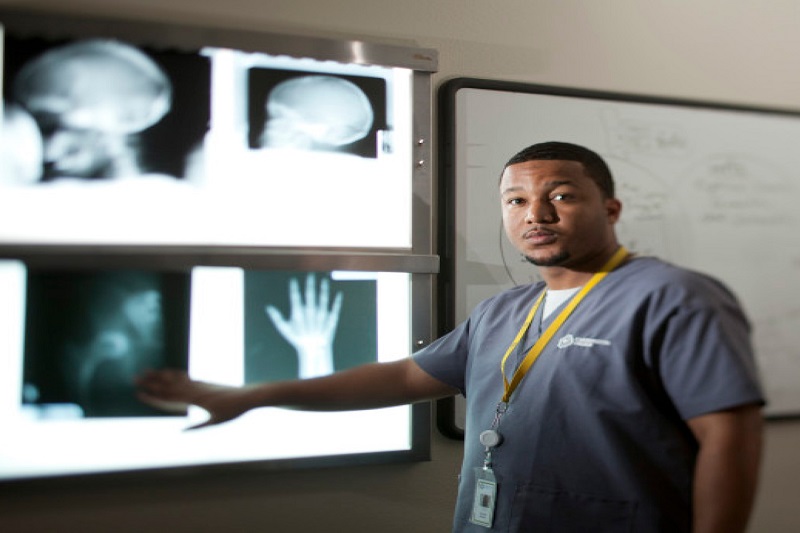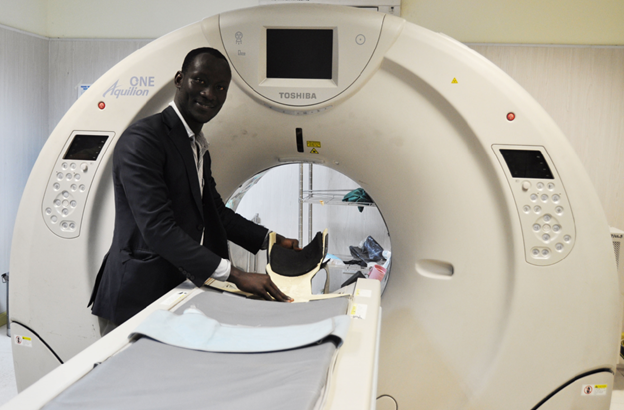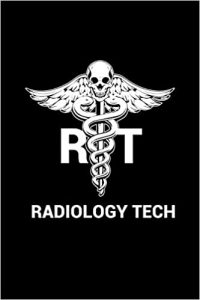
How to Become a Podiatrist
So you’re interested in becoming a podiatrist? That’s great! Podiatry is a fascinating and multifaceted field that can lead to a rewarding career. But before

Have you ever wondered what a radiology technologist does? How to become one? Wonder no more!
In this blog post, we will cover the basics of what a radiology technologist is, what their career looks like, and how you can become one.
Most people know that radiology technologists are an essential part of the medical imaging team. But we’ll discuss at length about their job and equipment too.
So, keep reading to learn more.
A radiologic technologist is a healthcare professional who uses imaging technology to diagnose and treat medical problems. They are responsible for operating various advanced imagery and diagnostic equipment that includes:
The resulting imagery—of bones, organs, tissues, or blood vessels—helps medical experts diagnose and cure illnesses and diseases.

Radiologic technologists usually work closely with radiologists in hospitals and clinics where they take images of patients and determine the suitability of those images for diagnostic purposes.
They may also work for outpatient imaging centers, mobile imaging services, or medical equipment manufacturers.
Their day-to-day work involves:
With additional training, radiology technologists may also administer radiation to treat cancer and other diseases.
Radiologic technologists are a type of medical imaging technologist. They use various imaging technologies such as x-rays, computed tomography (CT), magnetic resonance imaging (MRI), mammography, and bone densitometry to diagnose and treat medical problems.
Radiologists, on the other hand, are qualified medical doctors who interpret images and results to provide a diagnosis. They also help treat medical problems with radiation therapy.
There are several paths that students may take to fulfill their desire to become radiologic technologists.
Some technologists go for an accredited radiologic technologist program at a two-year school, while others complete a bachelor’s degree. Each career path requires different educational backgrounds when it comes to past certifications, but the subjects are mostly the same.
Let’s look at the most direct and commonly followed path to becoming a radiologic technologist:
Step 1: Complete high school.
The first thing you will need to do is complete high school. During your high school years, you should take a variety of classes in science and math. This will help you prepare for the courses you will need to take in order to become a radiologic technologist.

Step 2: Complete an accredited radiology technologist program.
After you have completed high school, you will need to attend an accredited radiologic technologist program. There are a variety of schools that offer these programs, so be sure to do your research.
The program will typically last two years. and you will learn how to use imaging technology to diagnose and treat medical problems. You will also learn how to operate various advanced imaging equipment.
Plus, you’ll study the following subjects.
Step 3: Get certified by the American Registry of Radiologic Technologists (ARRT).
In order to practice as a radiologic technologist, you will need to be certified by the ARRT. The ARRT is the world’s largest and most respected certification organization for radiologic technologists.
To become certified, you will need to pass an exam that covers a variety of topics related to radiology. Once you have passed the exam, you will be able to use the ARRT’s certification mark.
Step 4: Get a job as a radiologic technologist.
After completing your education and receiving certification, you will need to get a job as a radiologic technologist. There are various places you can find employment, including hospitals, clinics, outpatient imaging centers, mobile imaging services, and medical equipment manufacturers.
As a radiologic technologist, you will be responsible for preparing patients for imaging procedures, operating diagnostic equipment, interpreting images and results, and providing patient care.

Step 5: Maintain certification and continuing education requirements.
To maintain your certification, you must meet the ARRT’s continuing education requirements. You will also need to keep up with the latest advances in radiology so that you can provide the best patient care.
The ARRT offers a variety of continuing education courses that you can take to meet your requirements. You can also find continuing education courses online or through various other organizations.
That’s it! These are the five steps you need to take to become a radiologic technologist. Be sure to do your research and choose a program accredited by the ARRT.
According to the Bureau of Labor Statistics, radiologic technologists earn a median annual salary of $65000.
For example, the median annual salary for radiologic technologists in California is $70000, while the median annual wage for radiologic technologists in Texas is $60000.

Radiologic technologists also enjoy good job prospects, with the employment of radiologic technologists projected to grow by 9% from 2020 to 2030. This growth is primarily due to the increasing use of advanced imaging technology.
If you’re looking for a career that offers good job prospects and a high salary, pursuing a career as a radiologic technologist may be a good option. This career is also perfect if you enjoy working with technology and helping people.
But once you decide to take this career path, be sure to do your research and choose a program that’s accredited by the ARRT.
This will ensure that you receive the best education, are prepared for the certification exam, and become a high-performing radiological technologist.

So you’re interested in becoming a podiatrist? That’s great! Podiatry is a fascinating and multifaceted field that can lead to a rewarding career. But before

Becoming an economist in the United States can seem like a daunting task. You must meet many requirements before you can even begin to think

Pre-School 1. ABCs of Economics by Chris Ferrie, Veronica Goodman (Illustrator) Age: 18 Months-3 Years Chris Ferrie’s bestselling scientific series is expanding! It only takes

Download or Print These Activity Sheets Click the Link Below for More Kwanzaa Activities https://www.teachingexpertise.com/classroom-ideas/kwanzaa-activities/

Here’s a printable winter bingo read a book challenge for children to read books this winter. The bingo card has 24 spaces and a free

Every establishment in the United States has a heating, ventilation, and air conditioning system, commonly known as the HVAC system. If you empower yourself with

Do you want to become an architect but don’t know where to start? This blog post will provide you with all the information you need

What famous and popular African landmark comes to your mind? Would it be the Pyramids of Giza in Egypt? This would be understandable because the

Professions that allow you to combine entrepreneurship with passion are rare to find. Luckily, becoming a travel agent is one of those career choices that

Introduction You’ve probably read a few books in your lifetime. But have you ever read a book that changed your life? That’s what Mildred D.

So you’re interested in becoming a podiatrist? That’s great! Podiatry is a fascinating and multifaceted field that can lead to a rewarding career. But before

If you’re not familiar with Sharon Flake, she’s a prolific author of young adult literature. Her books explore tough issues facing teenagers, from racism and

Hi, art lover! We wanted to introduce you to Shane W Evans, an extremely popular illustrator, and author. Evans was born in Columbus, Ohio, in